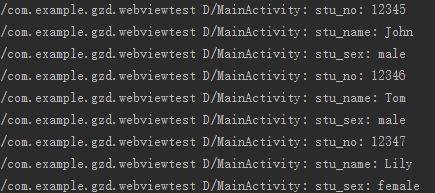C#(WinForm) ComboBox和ListBox添加項及設置默許選擇項。本站提示廣大學習愛好者:(C#(WinForm) ComboBox和ListBox添加項及設置默許選擇項)文章只能為提供參考,不一定能成為您想要的結果。以下是C#(WinForm) ComboBox和ListBox添加項及設置默許選擇項正文
JSON的界說:
一種輕量級的數據交流格局,具有優越的可讀和便於疾速編寫的特征。業內主流技巧為其供給了完全的處理計劃(有點相似於正則表達式 ,取得了現今年夜部門說話的支撐),從而可以在分歧平台間停止數據交流。JSON采取兼容性很高的文本格局,同時也具有相似於C說話系統的行動。
JSON對象:
JSON中對象(Object)以"{"開端, 以"}"停止. 對象中的每個item都是一個key-value對, 表示為"key:value"的情勢, key-value對之間應用逗號分隔. 如:{"name":"coolxing", "age"=24, "male":true, "address":{"street":"huiLongGuan", "city":"beijing", "country":"china"}}. JSON對象的key只能是string類型的, 而value可所以string, number, false, true, null, Object對象乃至是array數組, 也就是說可以存在嵌套的情形.
JSON數組:
JSON數組(array)以"["開端, 以"]"停止, 數組中的每個元素可所以string, number, false, true, null, Object對象乃至是array數組, 數組間的元素應用逗號分隔. 如["coolxing", 24, {"street":"huiLongGuan", "city":"beijing", "country":"china"}].
1.媒介
JSON數據是android收集開辟中罕見的數據格局。解析JSON數據有多種辦法。
1.1 應用官方自帶JSONObject
1.2 應用第三方開源庫,包含但不限於 GSON 、 FastJSON 、 Jackson ,本文重要引見由Google供給的GSON庫的應用辦法。
2.JSONObject的應用辦法
2.1 示例代碼
//org.json.JSONArray;
//org.json.JSONObject;
private void parseJSONWithJSONObject(String jsonData){
try {
//將json字符串jsonData裝入JSON數組,即JSONArray
//jsonData可所以從文件中讀取,也能夠從辦事器端取得
JSONArray jsonArray = new JSONArray(jsonData);
for (int i = 0; i< jsonArray.length(); i++) {
//輪回遍歷,順次掏出JSONObject對象
//用getInt和getString辦法掏出對應鍵值
JSONObject jsonObject = jsonArray.getJSONObject(i);
int stu_no = jsonObject.getInt("stu_no");
String stu_name = jsonObject.getString("stu_name");
String stu_sex = jsonObject.getString("stu_sex");
Log.d("MainActivity","stu_no: " + stu_no);
Log.d("MainActivity","stu_name: " + stu_name);
Log.d("MainActivity","stu_sex: " + stu_sex);
}
} catch (Exception e) {
e.printStackTrace();
}
}
2.2 字符串jsonData以下,圖為運轉成果
[{ "stu_no":12345,"stu_name":"John","stu_sex":"male"
},{ "stu_no":12346,"stu_name":"Tom","stu_sex":"male"
},{"stu_no":12347,"stu_name":"Lily","stu_sex":"female"}]

3.GSON的應用辦法
3.1 下載並裝置
•將下載的gson-2.6.1.jar復制到 項目目次->app->libs 文件夾下

3.2 辦法簡介
•toJson(params1),將傳入對象轉換為字符串
•fromJson(params1,params2),傳入兩個參數,將字符串params1轉換為params2指定的數據類型。
3.3 示例代碼
3.3.1 單個對象的解析
public class Student {
private int stu_no;
private String stu_name;
private String stu_sex;
Student(int stu_no,String stu_name,String stu_sex){
this.stu_no = stu_no;
this.stu_name = stu_name;
this.stu_sex = stu_sex;
}
}
// 序列化,將Student對象stu轉換為字符串str
Student stu = new Student(123,"Tom","male");
Gson gson = new Gson();
String str = gson.toJson(stu);
//反序列化,將字符串轉換為Student對象
jsonData = "{ \"stu_no\":12345,\"stu_name\":\"John\",\"stu_sex\":\"male\" }";
Gson gson = new Gson();
Student student = gson.fromJson(jsonData,Student.class);
3.3.2 JSON數組的解析(原生類)
Gson gson = new Gson();
int[] ints = {1, 2, 3, 4, 5};
String[] strings = {"abc", "def", "ghi"};
//序列化(serialization)
//將整數數組轉換為JSON數組
gson.toJson(ints); // ==> [1,2,3,4,5]
//將字符串數組轉換為JSON數組
gson.toJson(strings); // ==> ["abc", "def", "ghi"]
// 反序列化(Deserialization)
// 將JSON數組轉換為原生類數組
// ints2、string2與ints、strings相等
int[] ints2 = gson.fromJson("[1,2,3,4,5]", int[].class);
String[] strings2 = gson.fromJson("[\"abc\", \"def\", \"ghi\"]",String[].class);
3.3.3 JSON數組的解析(自界說類)
//關於相似於2.2中的jsonData,包括3個Student對象
//與原生類分歧,須要借助TypeToken取得希冀解析成的數據類型
//以下代碼運轉後,students包括三個Student對象
Gson gson = new Gson();
List<Student> students;
students = gson.fromJson(jsonData, new TypeToken<List<Student>>(){}.getType()); // ==>[stu0,stu1,stu2]
3.4 更多辦法
•GSON的 輕便的地方 在於其可以將字符串 主動映照 為原生或自界說對象,從而不須要手動編寫代碼停止解析。
•GSON的 更多辦法 可以浏覽GSON在github上的用法引見,README.md -> user guide。
以上內容給年夜家引見了Android中gson、jsonobject解析JSON的辦法詳解,願望對年夜家有所贊助。